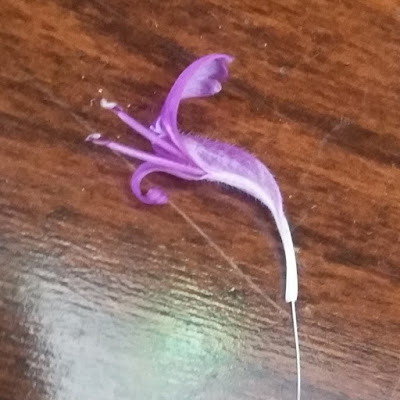Monday, 27 February 2017
Flowering Polka-dot Plant, H. Phyllostacha
Friday, 17 February 2017
House Plant Profiles: Cyrtomium falcatum
 |
| This is my young C. falcatum fern |
Lighting: Needs indirect light, not direct sun, which may scorch the plant's leaves. If the plant casts a shadow, the light source is probably too strong.
 |
| Like all ferns, this plant grows by unrolling new fronds, a process known as "circinate vernation." The unfurling fronds are colloquially called "fiddleheads," and commonly eaten as vegetables. |
Flowering by H. phyllostacha
My polka dot plant, Hypoestes phyllostacha, has unexpectedly flowered! In the middle of a Canadian winter, no less.
Thursday, 16 February 2017
Largest Bubble Nest Ever
So, another interesting fact about male betta fish; sometimes they will decide ro make a "bubble nest" (see picture.) This is a sign they are ready to mate, because after mating the eggs are held afloat in the bubble nest.
The nest pictured below is the largest Dawkins has ever made! Sometimes I catch him making one, and it's quite adorable to watch him blow bubbles. He's very discerning about the placement of bubbles, and a hard worker as you can see!
Meet my betta fish!
I recently took this picture of my betta fish, Dawkins, hanging out on a leaf. I adore this fish! He's got a very low-key personality for a betta, lives peacefully with other fish, and hardly flares his gills at anything (a show of aggression.)
If you are wondering why some of his scales are blue while the rest of him is white, that's because he is a special breed of betta that changes colour with age. I plan to write more about this "marbling" gene in a future post, as there is much more to say about it.
I named my betta after evolutionary biologist and author Richard Dawkins. His books encouraged my fascination with biology when I first read them as a high school freshman, and have a permanent place on my bookshelf.
Return of the Ferns
These pictures were taken with my cellphone camera, unmagnified. The Ceratopteris gametophytes are now large enough to be seen by the naked eye. One that I measured was ~ 1.75 cm.
Fern Gametophytes
 |
| Hermaphrodite gametophyte |
 |
| Male gametophyte |
 |
| Hermaphrodite gametophyte |
Growing Avocados, Part 1
The avocado pits I put in water are already starting to split open after a few days! The pits have a top and a bottom, so the shotglass helps keep them oriented the right way up.










